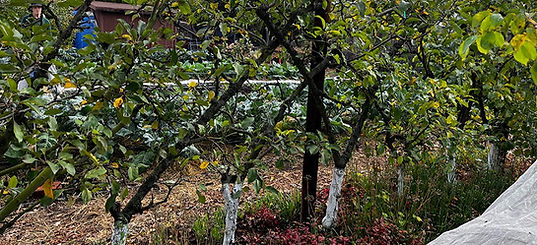History
Harvest for the Hungry Garden was founded in 1987 by Muchtar Salzmann, owner of Emerisa Gardens, and Marge Cerleti. They established the Garden to grow food for the hungry. Christ Church United Methodist generously loaned the use of a 3/4 acre parcel of land behind the church to help feed low income residents of Sonoma County.
By 1996 Geoff Rauch and Lyn Howe had taken over for Marge and Muchtar and initiated new programs for the Garden. In addition to growing organic produce, Lyn and Geoff added wildlife habitat areas, a drip irrigation system, and started new gardening practices such as the use of green manures (cover crops) and biodynamic compost.
If you want to create a wildlife sanctuary in your backyard, here are two resources for guidance:
Wildlife Habitat Garden
In 1998, the Garden received a grant from the Community Foundation Sonoma County to install the Wildlife Habitat Garden. In 1999, with a second grant from the Community Foundation, a neighborhood habitat workshop, led by Lyn Howe, was held to educate the Garden's residential neighbors about the value of cultivating wildlife habitat in their own backyards. One hundred people attended!
About one-third of our food supply depends upon an abundance of pollinators in our gardens, farms, and the wild. Valuable habitat has been lost or severely disrupted by population growth, pesticides, and pollution. Integrating food growing, herbs and native plants in the garden demonstrates the importance of their relationships. We've installed a bee box, birdhouses, birdbaths, and fruit-bearing and nectar-rich plants to encourage wildlife to nest, feed, and reproduce. The Wildlife Habitat Garden provides pollinators — bees, butterflies, wasps, beetles, flies, and birds — with over 200 habitat plants (73% of which are California natives).

Medicinal Plant Garden
The Medicinal Plant Garden was also designed and installed around 1999 with a generous donation of plants and expertise from Mom's Head Gardens (Vivien Hillgrove, owner) and the Sonoma County Herb Association. Lyn was also instrumental. Herbs can be used to treat illnesses like heart disease, sleep disorders, digestive complaints, skin problems, colds, flu and anxiety. Some boost the immune system and some of those plants are also culinary.
Volunteers cared for this specialty garden’s wide variety of North American, Mediterranean and Asian medicinal herbs throughout its development. At that time, medicinal plants included:
Agrimony, catnip, lemon balm, evening primrose, cramp bark (European cranberry bush), garlic, ginkgo biloba (maidenhair tree), echinacea (purple coneflower shown below), California poppies, clary sage, chives, yarrow, gumplant, thyme, Greek oregano, thyme, comfrey, spotted aloe, motherwort, Siberian ginseng, feverfew, calendula, white horehound, a hawthorn tree, rosemary, lady's mantle, pineapple sage, blue flax, creeping Oregon grape, marshmallow, self-heal, Greek foxglove, valerian, yerba mansa, mullein, Chinese chives (garlic chives), chaste tree, St. John's wort, wood betony and more.

Backyard Demonstration Garden
In 2000-01, Lynn and Geoff designed the Backyard Demonstration Garden—a 1,440 square foot area towards the back of the larger garden. It includes a variety of California native plants in a water-wise design. Its diverse collection of nectar-rich plants attracts native pollinators like carpenter bees, butterflies and hummingbirds. The dwarf persimmon tree, an espaliered fruit tree fence, and vegetables grown in raised beds continue to supply food for low-income Sonoma County residents.
